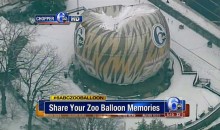Tourist Flights to Edge of Space
The latest space tourism venture aims to send paying customers to the edge of space and give them the same awe-inspiring view that adventurer Felix Baumgartner stared down upon last year – all for $75,000 a ticket.
Depending more on hot air than rocket science Arizona start-up, World View, has unveiled plans for a balloon ride to the stratosphere, offering passengers about two hours of space-like views from 19 miles above Earth.
While it’s not quite space — that starts at 62 miles — the plan requires approval from the Federal Aviation Administration, which oversees commercial space.
The company expects to begin flight tests of a demonstration vehicle this year in Arizona and plans to start selling tickets at $75,000 per person within a few months, said Chairwoman and President Jane Poynter – with commercial flights by 2016.
‘There are balloons this size that have already flown up many, many times for decades,’ Poynter said. ‘From a technical point of view this is incredibly doable, low risk.’
The selling point is the view of the Earth and seeing its curve, she said. The venture isn’t designed for passengers to experience weightlessness.
Indeed, the flight will be more like that of Red Bull daredevil Felix Baumgartner, the Austrian adventurer who leapt from a balloon 24 miles above the Earth, smashing the sound barrier during his descent and landing safely.
‘We promise we won’t open the door and have you jump back to Earth,’ Poynter joked.
The flight would take 90 minutes to go up at about 1,000 feet a minute, set sail up high for 2 hours with an emphasis on smooth riding, hit an altitude of 19 miles and then come back down in 40 minutes, Poynter said.
The capsule’s interior will be roomy enough for its eight passengers to walk around and even get a drink at an on-board bar – but unfortunately there will be experiencing of weightlessness.
‘Seeing the Earth hanging in the ink-black void of space will help people realize our connection to our home planet and to the universe around us, and will surely offer a transformative experience to our customers,’ Jane Poynter, World View’s chief executive officer, said in a statement.
‘We look forward to pioneering this new, accessible and affordable spaceflight regime, and to sharing the breathtaking, once-in-a-lifetime experience with people from around the globe.’
By comparison, rides aboard SpaceShipTwo – a suborbital six-passenger, two-pilot vehicle owned by Virgin Galactic, an offshoot of Richard Branson’s London-based Virgin Group – is expected to reach about 68 miles.
At that altitude, passengers will experience a few minutes of weightlessness in addition to seeing the curvature of the Earth set against the black sky of space.
World View capsules would be propelled by a 40 million cubic-foot (1.1 million cubic-meter) helium balloon and a steerable parafoil, an inflatable wing-shaped parachute – which would steer them gently to the ground once they disconnected from the giant helium balloon.
Outside magazine space expert Scott Pace, a former NASA associate administrator now space policy director at George Washington University, agreed that this is technically feasible.
He said the issue is whether there’s enough of a market for it to be financially doable, calling it ‘an interesting market test.’
Pace said the while there are many space tourism ventures, it is not quite right to call the field growing. It is still embryonic.
A few people have paid tens of millions of dollars to fly to the International Space Station and others have paid to fly in high altitude jets. But how many people will pay for near space experiences, he asked.
Poynter said she has no doubt that there’s a market with other firms like Virgin Galactic selling so many tickets for yet-to-fly rides.
‘Space tourism is here to stay,’ said Poynter.


